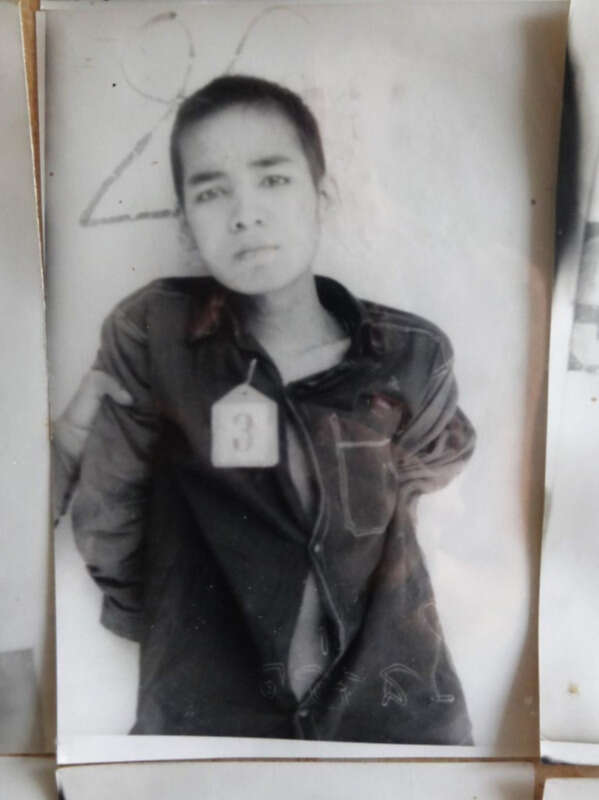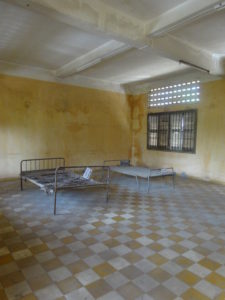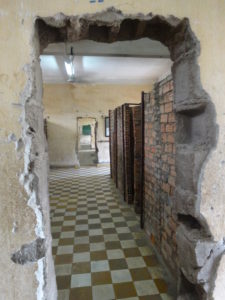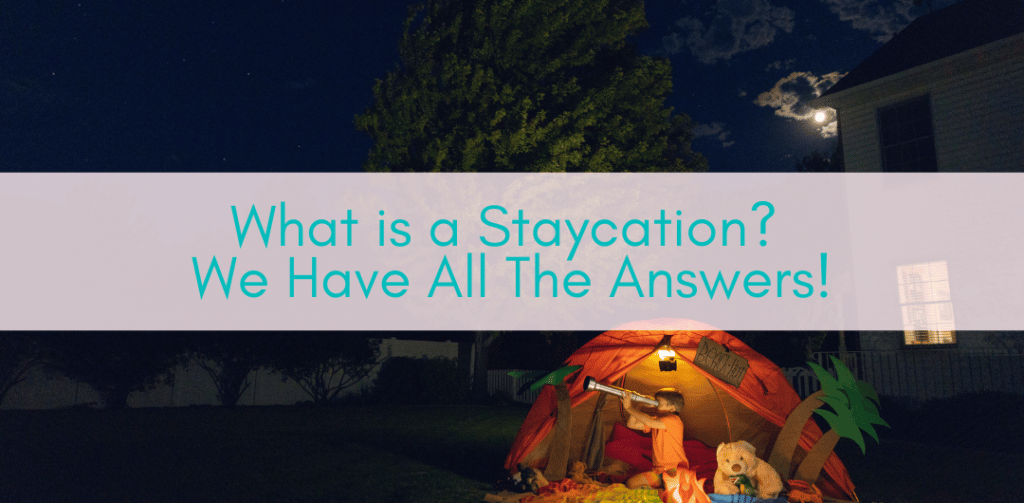My Memorable Trip to Cambodia
Trigger warning: This post contains descriptions of child sex trafficking in Cambodia, animal abuse, and genocide.
My Memorable Trip to Cambodia
Cambodia still haunts me. My feelings toward this Asian country are convoluted. I find that I want to cradle it in my arms, as if holding an injured thing. I feel great compassion towards its people, as well as love and sadness. But Cambodia is strong and has proven resilient in many ways. This Asian country has definitely left its mark on me. Read on about my Cambodia trip and the heartbreaking things I experienced.
Siem Reap
 Our Hotel
Our Hotel
Our first stop on our Cambodia itinerary was Siem Reap. The dusty, busy city was still very much alive when we arrived that evening. The setting sun was full and warm, suspended low in the hazy sky. Our tuk-tuk pulled up in front of our hotel. We spilled out of it, trudged to our room, and dropped our packs. As I plopped down on the bed I looked up at the green painted wall. The plaster crumbled in places. There was a stark white sheet of printer paper titled “Our Hotel Rule.” Among the list of rules was one that felt as though it sucker punched me right in the gut. “No Child Abuse In Room.”
The Tuk-Tuk Driver
Later that afternoon, a male traveler told us that during his ride from the airport his tuk-tuk driver offered to take him to pick up a child of his choosing. “You have a good time,” the driver coaxed, even after he had declined the offer a total of three times during the ten-minute ride.
Sex-Trafficking
It’s not uncommon to see little girls in heels on the street. In many windows there are posters of small dirty faces with tear-filled eyes and heartbreaking pleas. One such poster read “Please Help Me”. Below this it said “Volunteers Needed.” Sex trafficking is a horrendous problem in countries like Cambodia. The outcry has remained heavy on my heart.
Angkor Wat
Siem Reap is home to Angkor Wat. It was also one of the filming locations for Angelina Jolie’s Tomb Raider and the next stop on our Cambodia itinerary.. I’ve written a previous post about Angkor Wat specifically. You can check out some photos and read about my experience at The Temple City here. Due to the rising tourism, Siem Reap is probably one of the safest cities in Cambodia. Despite your occasional scam or pickpocket, there doesn’t seem to be much crime. The people are kind and the prices are fair. The landscapes are often beautiful, and to be submersed in its culture was eye opening. After just a few short days, we headed south to Cambodia’s capital.
Phnom Pehn
 City Center
City Center
After a six hour bus ride we arrived in Phnom Penh’s city center. As with most SE Asia cities the traffic was heavy. The sounds were abundant, and the food was plentiful. We decided to stop and grab a bite. We also tried the local beer, Angkor. As for the orange in my Cambodia glass… well… that’s just Orange Fanta. I was having a serious craving!
Dog Meat
As we sat outside doing some people watching and soaking up our surroundings, I quickly found out that dog meat is just as common as a cheeseburger. Not only can you find it on many menus, you’ll also see sizable (40lbs or bigger) dog carcasses on skewers or rotisseries out front of street café and restaurants. All the while, adult dogs bark out back, chained to metal posts in the ground, and puppies play in cages. This is just part of every day life in Cambodia.
Outdoor Fresh Market
The outdoor fresh market is several blocks long and equally as wide. And wow, was that an experience in itself! I watched a woman sit and pick at her toenails while a mixture of animal blood and dirty water ran down a gutter beside her. When a customer approached and asked for some fish, the woman hurriedly grabbed a few bare-handed. She proceeded to wrap them in brown paper. Chickens with broken feet lay nearby. They were unable to do much, and are then slaughtered on the spot when purchased. The fresh market is the most “fresh” I’ve encountered. One quick trip through was truly all my stomach could handle. It’s important to keep in mind that this is all very culturally acceptable and considered the “norm.” Other parts of the market were more enjoyable for me. The fresh and dried fruits, the nuts, the vegetables, the goods, textiles, and toys were great. If you need something, the odds are quite high that you’ll find it here.
Movie Time
After several hours exploring the city, we arrived back at our hostel where the girl at the front desk told us they were showing David Puttnam’s film The Killing Fields every night at 8 o’clock. A 1984 movie depicting the ruthlessness of the Khmer Rouge regime from the viewpoint of two journalists. The drama is over two hours long and provided an education I hadn’t yet had. I thought it might prepare me for the following day when we were to visit The Killing Fields. But now I know that nothing could have possibly prepared me for what I was going to see.
The Killing Fields at Choeung Ek: A Brief History
Pol Pot
The Khmer Rouge was led by Pol Pot, a name I literally had only heard while jamming out to The Dead Kennedy’s “Holiday in Cambodia” on Guitar Hero years before. I had no idea what that song was about. When I listen to it now, it means something entirely different. It’s dark and horrific, and I’m including it here. But please know if you choose to watch it that it includes some graphic footage of The Khmer Rouge.
The Khmer Rough Reign
The Khmer Rouge reigned from 1975-1979, just 40 years ago. Their goal was to turn the country into a socialist agrarian republic, founded on the policies of Maoism, a kind of Marxism. Pol Pot established the state of Democratic Kampuchea and aimed to establish a classless communist state based on a rural agrarian economy, embracing the total rejection of both capitalism and the free market. Whether brutally murdered, overworked, starved, or malnourished, under his leadership it is estimated that 2 – 2.5 million Cambodians were killed. With the population being roughly 8 million, one out of every three to four Cambodians lost their lives. Meanwhile, the rest of the world knew nothing.
The Killing Fields
The next morning we hailed a Tuk-Tuk and traveled roughly ten miles (16 km) south of Phnom Penh to Choeung Ek, the location of several of The Killing Fields and the next stop on our Cambodia itinerary. Having been to Auschwitz and Birkenau (which you can read about here), I can say with certainty that The Killing Fields and Tuol Sleng come in close second for most somber, heart-wrenching, and melancholy sites to see.
The Tour
Once equipped with your audio guide and map, you’ll listen to the narrator explain the significance of certain areas, specific events that took place, as well as hear people tell their own stories and give their personal accounts. There are parts of the grounds that are roped off due to erosion where fragments of bones, teeth, and clothing can still be seen after heavy rainfalls. And if you see any of these, you’re encouraged to tell a guide or grounds employee.
The Killing Tree
Probably the most easily remembered landmark is The Killing Tree, where soldiers in the Khmer Rouge would hold babies and small children by their legs and beat them against the tree trunk until death.

The Khmer Rouge regime arrested and eventually executed almost everyone suspected of connections with both the former and also foreign governments, as well as professionals and intellectuals. As a result, Pol Pot has been described as “a genocidal tyrant.”
Choeung Ek Memorial
At the center of the grounds you’ll find The Choeung Ek Memorial, a Buddhist commemorative stupa which stands 203 feet (63 meters) high. When you make your Cambodia itinerary, make sure to include this memorial. It is filled from top to bottom with skulls, and its glass sides allow visitors to witness the sheer number of them. Upon closer speculation of the skulls, one can see the trauma inflicted prior to execution. It is a quiet, respectful place and shoes are to be taken off when entering.
Tuol Sleng
The S-21 Museum
About 9 miles from The Killing Fields you’ll find the S-21 Museum, otherwise known as Tuol Sleng. This is a complex of five different buildings and was formerly known as the Chao Ponhea Yat High School. The Khmer Rouge quickly converted it into a prison (Security Prison 21). It served as a detention, interrogation, and torture center for the full four years of its operation. An estimated that 20,000 people were imprisoned here during 1975-1979, which is a conservative number. It is also on record as just 1 of at least 150 torture and execution centers established by the Khmer Rouge during those years.
Meeting a Genocide Survivor
The day I visited, I was able to meet a Cambodian survivor who lived through the Khmer Rouge and Pol Pot’s genocide. He wrote a book telling of the account and was there for a signing. I stood among others as he shared his truth and spread awareness. It was very moving and quite the gift.
The Most Memorable Room
I walked through the complex, left one building and entered the next. One room will forever remain in my memory. A room full of faces. Hundreds of them. Thousands of them. Men, women, and children. Mothers and fathers. Brothers and sisters. Teachers, doctors, mechanics and the like. Just your average every day person who endured the atrocities of the Khmer Rouge.
The Boy with No Name
And then I saw a photo. A hand roughly held a boy’s arm. He wore disheveled clothes. His mouth was set. But his eyes were what caught mine. The stillness of his eyes. They burned into me and I couldn’t move. I didn’t want to. I was paralyzed in a moment where the only thing I could possibly do was offer recognition. To say, “I see what happened to you. I know now. And you won’t go unremembered. This will not be forgotten. You will not be forgotten. I see you.”
This boy with no name. Number 3. I want the world to see him. I want the world to know.

Some Useful Facts
Entrance Fee
The entrance fee is a mere $6 USD (approx 24,400 CR) and you are provided an audio guide. Entrance fees for S-21/Tuol Sleng Genocide Museum are $5 USD without an audio guide and $8 USD with one. I highly recommend you cough up the few extra bucks for the audio guide.
Tuk-Tuk Fee
Expect to pay somewhere around the ballpark of $12 USD for a one way tuk-tuk trip from pretty much anywhere around the city center to The Killing Fields. Keep in mind, however, that you’ll probably also want to see Tuol Sleng, and if you factor in this extra stop for your driver and pay accordingly, they will shuttle you where you need to go throughout your day and for the duration of your trip. Expect to spend a few hours at both The Killing Fields and Tuol Sleng. A fair price would be around $20 USD. If this is a bit steep for your budget, try sharing the tuk-tuk with a fellow traveler and split the fee down the middle. You can also haggle at this point, but do keep in mind that your driver will do quite a bit of waiting around for you during the heat of the day.
Sihanoukville, Cambodia
We were dirty when we arrived in Sihanoukville. Our packs weighed us down as we stepped off the bus onto the dirt road, but the breeze coming off the ocean lifted our spirits. Trees swayed with calm reserve and the waves softly crashed against the sand. The seasoned smell of grilled food drifted from the seaside huts. I exhaled just as deeply as I had inhaled, and the effects of such a heavy week seemed to lighten.
My Heart was Burdened
My heart was burdened with such horrendous stories of fear, torture, and death. But it wasn’t only the past that was making me feel sticky and dismal, it was also the present state of things. Human trafficking of the innocent, of the helpless, of children. It was the knowing. For me, it reached so far down into the depths, I didn’t know how I would ever dislodge it. It stuck to me like a wet filthy rag. It left a residue which seemed so permanent, no matter how hard I tried to shake it.
Time on the Beach
I stood on the beaches of Sihanoukville overlooking the Gulf of Thailand. The sand between my toes felt nice. I listened to the seabirds chatting and tried to drink in every beautiful color the sunset had streaked across the sky. I felt moved and I felt grateful. But I was also heartbroken and full. So full of appreciation for this life. And so determined to live it.
**If you feel a calling in your heart to find out more information about human trafficking, intern, volunteer, or donate, please feel free to check out these websites. I am not affiliated nor do I receive anything from these organizations if you wish to do so.
http://hopeforjustice.org/cambodia/
Topics
Subscribe
Subscribe for news, updates, giveaways, and more!
JOIN GIRLS WHO TRAVEL
Join our inclusive community
of tens of thousands of women who
share your passion for travel in our
Girls Who Travel Facebook group!














2 Comments
Courtney,
Just read your article, my heart feels heavy and tears sting in my eyes. I know the story about Pol Pot and the The Khmer Rouge as I traveled in Cambodia before … Still the way you explain the sights you visited make my feel sad. You write like I’m there, like I’m visiting the sights with you.
Thank you so much for sharing this article with Girls Who Travel and introduce us to the little boy in the picture.
Hello Martine! Thank you for taking an interest in my story and experience… my articles would be fruitless without readers like yourself!